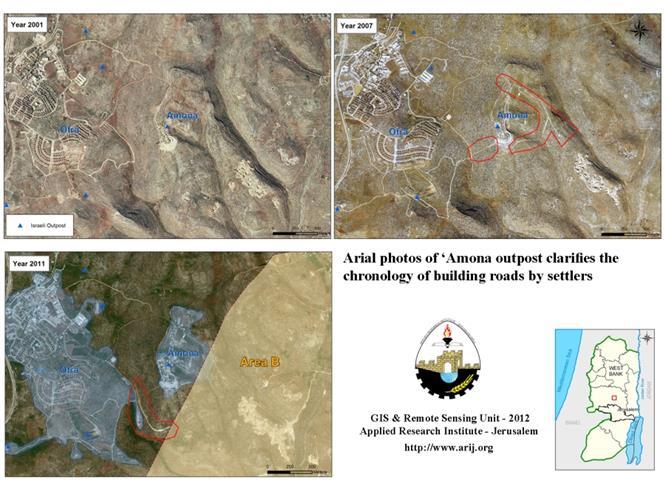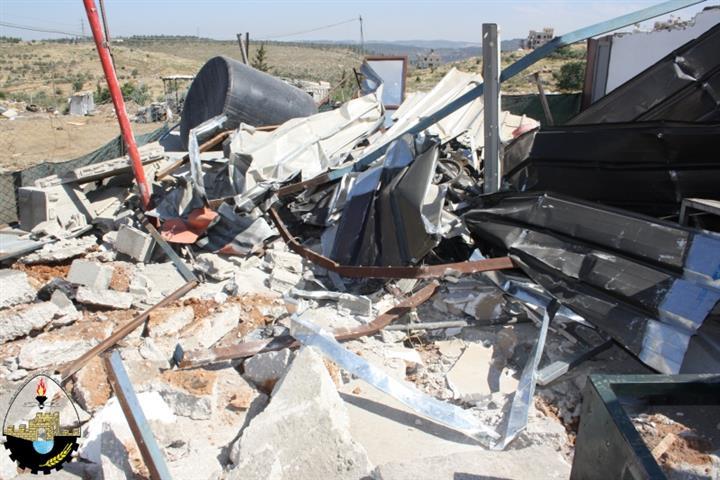1- Proposed Legislation to Facilitate the Settlers Taking over Palestinian lands
On February 20, 2012, the Israeli daily newspaper “Haaretz” revealed about an Israeli colonial plan for the interest of Israeli settlers to take over Palestinian lands to build dirt roads in the West Bank Territory. According to the newspaper, the “Israeli Civil Administration” which is the managerial façade of the Israeli Occupation Army in the West Bank, is proposing a new legislation that would enable Israeli settlers to open dirt roads without the preconditioned approval of the Israeli Civil Administration if the aim of such roads is to protect the so called “state owned lands”.
The newspaper indicated that usually, the building of any new road or changing in its route requires full approval from various levels including the Israeli National Planning and Building Council, followed by issuance of an individual building permits (a process that takes long time before being finally approved and adopted), where according to the proposed legislation, the settlers will take the approval for building a road in limited time as long as it is a dirt road.
Old- New Law
It is worth mentioning that the proposed Israeli legislation is not emerging out of nowhere, where in February 1984 the Israeli Government published the “Regional Partial Outline Road Plan No. 50”, which was based on an earlier plan No. (T/M/A/3) and prepared by the “World Zionist Organization” to integrate Israeli and West Bank roads network connecting the roads of settlements with the Israeli roads grid, bypassing the Palestinian communities centers of population.
Following the issuance of the plan, more than 1600 objections were submitted by Palestinian land owners affected by the plan, and on March 12, 1991, the Israeli committee established for such plan revised the objections submitted by the Palestinians, rejected all petitions, subsequently sanctioning all roads linking settlements and outposts. Ultimately, this new (more like re-invented) proposal, reflects an Israeli political desire to pave the way for the Israeli settlers to move forward to construct such roads, actually more of such existing roads mainly to link the outposts with the settlements to support the development of outposts which is actually a nucleus existence for new settlements.
Furthermore, the activation of the Law No. 50 -1984, will end up with dramatic consequences for the Palestinian land owners mainly those whose lands located nearby the Israeli settlements and the outpost, where on one hand, their lands would be legitimate targets for the Israeli settlers to build roads, on the other hand the geographical contiguity between the Palestinian communities in the West Bank would be further interrupted by these roads. Some of the examples on the consequences of the proposed legislation are listed below:
a) ‘Amona Illegal Outpost Northeast of Ramallah: Even before the proposed legislation being approved, the Israeli settlers of ‘Amona outpost had built new dirt road to link their outpost with the nearby settlement “Ofra”, even though parts of ‘Amona outpost lands located in area B1 (according to Oslo II Agreement of 1995), where part of the newly built roads located in that area.(Haaretz, Feb 20, 2012). See Photo 1

Photo 1: Arial photos of ‘Amona outpost clarifies the
chronology of building roads by settlers
It is worth mentioning that the illegal outpost of ‘Amona is located out of the designated master plan2 of the settlement of ‘Ofra which means that the outpost is a nucleus for a new future settlement on its own.
b) Nili Settlement Northeast of Ramallah: In a session at the Israelimartial court held in ‘Ofar military base northwest of Ramallah in early march 2012, the Israeli Civil Administration revealed that the implementation of the new proposal for the dirt roads is already on the move and that sanctioning such roads has already happened even before it becomes a legislation, such as the new road encircling Nili settlement northwest of Ramallah. Moreover, during the held session, the court asked the “Lieutenant Tsefika Cohen” the head of the infrastructure department at the Israeli Civil Administration, if they notified the head of Deir Qeddis village council (the Palestinian village located to the south of the settlement and where the road will run on its land) about their intention to build the road, and he answered : “There is no need for this because the road would be built on a state land which means that there is no need to coordinate with the Palestinians”.(Haaretz, Feb 20, 2012).
2- 475 km Rail Network to tear the West Bank
On February 28, 2012, “Haaretz” newspaper published an Israeli plan for a rail network stretching 475 kilometers in the West Bank.
According to the newspaper, the plan prepared by what is called “Israel Railways” company upon the request of the Israeli Transportation Minister “Yisrael Katz” to establish 11 new rail lines in the West Bank. Last year the Israeli Minister declared his intention to reactivate the railway that links Al-‘Afoula city inside the Green Line with Jenin Governorate in the northern part of the West Bank, and to establish a railway that links Ras Al-‘Ein community inside the Green Line with the illegal Israeli settlement of Ariel in Salfit Governorate.
The proposed plan, according to “Haaretz” newspaper is to construct 475 km railway that runs across the West Bank with several axes as follows:
-
The first one called “Daher Al-Jabal” which links Jenin Nablus, Ramallah, Jerusalem, Ma’aleh Adumim settlement, Bethlehem, Hebron.
-
The second axes is called the “Jordan Valley”, extends along the Jordanian borders and links Jericho, Dead Sea, Bisan, Ilat, and from Ilat to Haifa and then Syria in the future.
-
Moreover, the plan includes many other axes such as:
-
Nablus – Tulkarim axes.
-
Ramallah- Allenby Crossing Border axes.
-
Jerusalem Tel Aviv axes.
-
Jerusalem- Lod (Al-Lid) inside the Green Line.
-
Jerusalem – Ramallah (starting from Jerusalem and wrapping around Ramallah and linked with the central railway station).
-
Kiryat Gan inside the Green Line – Hebron.
Hebron – Beersheba inside the Green Line. See Map 1:

Map 1: The proposed West Bank Train Track
Catastrophic Geopolitical Consequences
Clearly and without doubt, the two proposed Israeli colonial projects that the Israelis are preparing and pushing for, serves the interest of the Israeli prolonged occupation of the Palestinian Territory, with the aim to ensure a long-term control over the West Bank in addition to eliminate any chance to reach a just and lasting peace agreement with the Palestinians based on “Two State Solution” where an independent, contiguous, Palestinian Territory constitute the main elements of that solution. Even more, Israel wants to make sure that its existence in the West Bank becomes an integrated reality and inseparable from the Palestinians, hence the concentration on infrastructure that links all life elements of Palestinians and Israelis together.
Legal & International Status
The Israeli extremist right-wing government headed by Benyamin Netanyahu is moving steadily toward pouncing on the remaining parts of the West Bank by systematically planning for expansionist projects that aims to topple the peace negotiations with the Palestinians to satisfy their ideological colonial behavior. The ongoing Israeli projects that targeting the Palestinian lands constitute a grave breach for the International law rules and conventions
-
Article 53 & 147 of the Fourth Geneva Convention of 1949 indicated that: Extensive destruction and appropriation of property not justified by military necessity and carried out unlawfully and wantonly, is a grave breach of the Convention.
-
Moreover Art. 23 of the Hague Convention of 1907 also provides: In addition to the prohibitions provided by special Conventions, it is especially forbidden to destroy or seize the enemy’s property, unless such destruction or seizure be imperatively demanded by the necessities of war.
-
Also under the Universal Declaration of Human Rights Adopted and proclaimed by General Assembly resolution 217 A (III) of, December 10, 1948, Article 17 reads: ‘No one shall be arbitrarily deprived of his property.’ Which means it bans Israel from destroying or confiscating the property of the Palestinians at any case.
1 Lands classified as area B at Oslo II Agreement of 1995: ThePalestinians have full control over the civil responsibilities and Israel continues to have overriding responsibility for security.
2Master plan for a settlement: area adopted by the “Israeli Civil Administration” as the settlement area in addition to an area allocated for the future development and expansion of the settlement.
Prepared by:
















